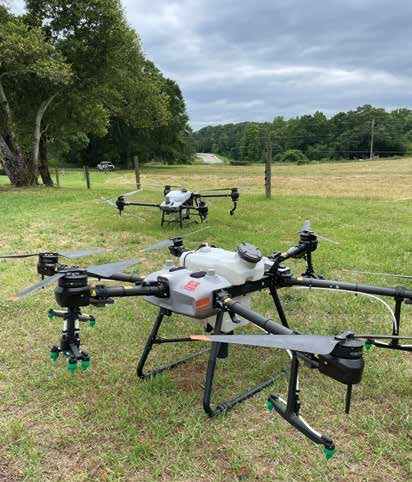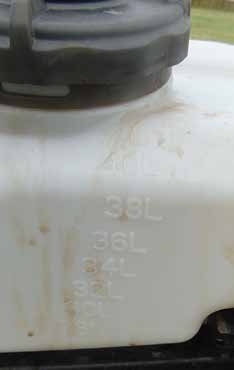12.Considerations Before Purchasing a Drone
RESOURCES - PUBLICATIONS
The Evolution of Spray Drones, Their Capabilities and Challenges for Pesticide Applications
12. Considerations Before Purchasing a Drone
Drones, particularly spray drones, are not cheap, especially when you add the expenses of generators, trailers, and supporting equipment. Individuals who are considering purchasing a spray drone should spend time thinking about how they will use the drone and their return on investment in the form of saving time, generating profits, or solving particular application problems. While the marketplace is not very competitive now, different companies manufacture a number of spray drone models.
Timely Applications Can Justify the Cost
Some drone owners upgrade their drones every few years because newer models may provide distinct advantages, such as being able to fly at a higher speed. A farmer might be able to justify the cost of a drone based on the need to make timely applications, particularly to high-value cash crops like watermelons, tomatoes, sweet corn, or seed corn. In some seasons, manned applications may be delayed because of high demand during critical time windows or sub-par weather and field conditions. It’s not that there is a problem with fixed-winged aircraft or helicopters, but your need to get a timely spray application might not align with their availability or with weather conditions.
Even if growers see drones as worthwhile purchases and good fits for the farm, then they still must consider who will make the applications and whether there will be time to do their own spraying. Most importantly, growers must carefully consider who will be responsible for obtaining and keeping up with the changing technologies and regulations.
Spray drones are time-consuming for meeting the regulatory challenges (for example, obtaining pilot certifications) and obtaining any waivers that are needed to operate drones for spraying pesticides and other products. For any drone to pay for itself, growers must understand how the drone operates and work out how they will find the time and labor during the busy season to make those applications.
Most growers are so busy with tillage, planting, and side-dressing that they have little time left for spraying with drones. This is why many farmers currently prefer to hire commercial applicators for chemical applications. Time challenges do not change just because you have a drone. Using a drone might even be more difficult in busy times because the visual observer requirement currently in place ties up two people. This alone may be impractical if you do not have more than one person working on a regular basis.
Some farm operations may not have any labor available from spring through midsummer to perform drone pesticide applications. Thus, buying a drone to perform preplant herbicide applications in the spring (including cover crop termination) may not be a great fit for labor demands. The same would be true for late-season insecticide or fungicide applications in the spring for fall-seeded small grains like wheat.
DRONE FACT
Farmers might be able to justify the costs of drones based on their need to make timely applications where fields are inaccessible because of topography or rain. This is especially true for high-value cash crops like watermelons, tomatoes, sweet corn, and seed corn.
More Than an Alternative It is important to highlight that spray drones are more than just an alternative to traditional aircraft. Spray drones may be the only option available to apply to fields with unique shapes, small sizes, or flight obstacles that traditional ground equipment and aircraft cannot perform. There are many instances of ground-based or manned aerial applicators who do not want to treat smaller fields because it is not profitable for them. It is becoming more common for application companies to refer the work they do not want to perform to drone companies.
A couple of points are worth considering from the perspective of a grower who is considering buying a spray drone. The first question is: Am I really going to use it? Without a lot of use it would be difficult to justify the cost of a drone because of the accelerated electronic depreciation of most drones. Also, keep in mind that the drone you buy today could become obsolete in the near future. It is worth mentioning depreciation here because spray drones are electronic consumables, just like televisions, computers, phones, and tablets. They do not hold value over time, even if they are still brand new in their boxes and never opened.
The second question to ask is: Does the farm have enough acres to help spread the cost of the drone over those acres? This question is no different than one you would ask for ground equipment. One farmer may have a land base large enough to spread the cost of a $650,000 self-propelled ground sprayer, while another farmer with less land would not be able to pencil it out. Before you buy a drone, you should calculate the costs of buying and operating it, and then compare that with how much you are charged for custom applications.
Considerations for Using Drones Commercially
The number of commercial businesses offering drone services to their customers has been increasing steadily. These commercial businesses can gear up by employing multiple drones to make applications.
Asking questions about doing commercial work with drones are similar to questions you ask about commercial ground, plane, or helicopter applications. How many acres are best applied with a drone versus other sprayer types that are already available? What will my labor and equipment costs be? What is my cost per acre for the application? What is my expected return on investment? These and many other questions are all part of the equation of making sure the spray drones you are considering will provide enough value to your farm operation.
As you explore purchasing a drone for commercial use, consider these questions:
- Will this be my full-time business or just seasonal?
- What crops am I going to target?
- What licensing and certification will I need from the state pesticide regulatory agency and FAA?
- Does my state allow drone pesticide applications if the pesticide label does not provide specific instructions about drone sprayer use?
- Can I find reasonably priced commercial insurance? What will it cost? Drones cost as much as new cars or trucks these days, so you should think about getting insurance on them for the same reasons you do for your other vehicles.
- What market(s) can I fit into? Some operators focus on row crops (like spraying fungicides on corn and soybeans). Others use their drones to treat specialty crops like blueberries, grapes, or other fruits. Outside of crop production, drone applications can be used for forests, ponds, highways, and livestock operations.

The drone model you choose comes down to personal preferences and recommendations from applicators with prior experiences.
- Do I plan to use a drone under a government contract? Make sure that performing work for a government agency does not require using a drone that is different than what you have or what you are thinking about purchasing. The United States Department of Agriculture and the United States Department of Defense have concerns about digital security breaches, so they don’t allow drones that are manufactured by certain companies to operate on state and federal property.
- How many acres can I cover with a single drone? You will want to ensure your fleet is big enough to cover enough acres to make your investment worthwhile.
- What is the backup plan if a drone goes down?
- Will I rely on someone else to keep track of the regulations? Either you or someone on your team will need to be comfortable with understanding the ever-changing state and federal rules, regulations, and policies. Rules can be complex and require more than just filling out paperwork. Putting those requirements into practice will require forethought and patience.
- Can I find qualified labor? Justifying the cost of a drone may not be a problem, but finding people to work will be tough when there are labor shortages or when you need to find workers who can put in the long hours often necessary in agriculture. Many potential employees are unwilling to work the long hours outdoors, evenings, and weekends that are required in agriculture.
- Are the products your customers commonly use labeled for aerial applications?
- Will you or the customer provide the chemicals for applications?
- What size spray tank will you need? Larger fields require tanks with larger capacities. But larger drones bring more stringent FAA regulations. Depending on the market, a drone with a smaller tank capacity might work just as well.

Several spray tanks have labels that indicate different volumes, which can be helpful for accurate mixing. This 38-liter tank is equivalent to 10 gallons.
- Does the drone manufacturer provide customer service? Are they able to supply parts quickly to repair drones? • Where will I get the drone repaired?
- How will I map the field for boundaries and obstacles with highest efficiency?
- Can I be competitive with manned aerial and ground applicators?
- What will be my travel limit? Some applicators have been known to travel as many as 12 hours to do a job, while others will not take on work outside of a two-hour radius.
- How will I promote my business and gain new business outside of my area, since spray drone trailers can easily travel on highways across the state?
- What software comes with the drone package? Every drone comes with a software package. This question is important, because at this time, you cannot add third-party vendor packages to spray drones as you commonly can with ground equipment. Even if a vendor says they have better technology and software, drone manufacturers will not allow access to their drone’s software. The FAA may need to permit the adaptations because the software could compromise flight capabilities.
- How comfortable are you using the software and flying the drone? Is it worth investing your time to understand the software by accessing websites and attending trade shows? Make personal contact with manufacturing representatives or with extension educators who can demonstrate their drones at your place of business.
- What other supplies or equipment will you need to purchase? As you have read in this publication, the drone is just one component of the operation. Think of your total cost by adding expenses such as an additional truck, specially designed trailers, generators, tanks, spare parts, and other supplies. These all will raise the total investment required for a drone spraying operation. This may be especially challenging for start-up businesses.
- Will you be doing only single-rate applications? Or will you also consider variable-rate applications? Not all drones can do variable-rate applications so you will need to think ahead.
- Do you plan to also provide application services for applying dry products like urea or cover crop seeds? If so, then you need to think about purchasing a dry box that can handle different dry product rates.
- What will be the equipment depreciation?

A drone applying fertilizer or cover crop seeds can add a lot of
value to a drone.